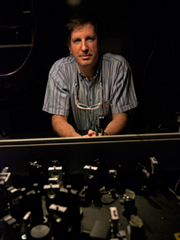The research activities of Diego Yankelevich are mainly focused on the application and development of opto-electronic systems for biological spectroscopic and microscopy applications.
- In collaboration with Dr. Laura Marcu (BME, UCD) I participate in the development of an improved and clinically compatible compact fiber-optic based configuration for simultaneous time- and wavelength-resolved fluorescence spectroscopy. This device performs the rapid acquisition of fluorescence decay profiles in multiple spectral bands from in-vivo tissue excited with ultra-short UV pulses. Parameters extracted from the decay profiles provide valuable information for disease diagnosis.
- Photoacoustic imaging is a technique based on the detection of acoustic waves induced in tissue by the absorption of a short laser pulse. The mechanism beneath relies on the contrast determined by differences in optical absorption of various types biological molecules (hemoglobin, lipids, structural proteins, etc.). The average optical penetration depth in the 600-1000 nm range is on the order of tens of millimeters; therefore, this spectral range is very suitable for photoacoustic imaging of biological tissue. In collaboration with Dr. Rodger Cudney (CICESE, Mexico) and Dr. Laura Marcu we are investigating the applicability of periodically and aperiodically poled lithium niobate crystals (fabricated at CICESE) as an alternative to optical parametric oscillators for Photoacoustic imaging of biological tissue.
- For more than three decades it was known that collagen, the most abundant protein in vertebrates, efficiently produce second harmonic generation. In collaboration with Prof. Andre Knoesen (ECE UCD) and Dr. Karen Reiser (Neurology UCD), we are using sum frequency generation spectroscopy, which is a spectroscopy method that measures the presence and noncentrosymmetry of molecular groups, to identify the molecular entities within collagen that are responsible for the second harmonic generation. In addition, I am working in biological microscopy imaging instrumentation that relies on ultrashort laser pulses to quantify structural disorder in collagenous tissue.





